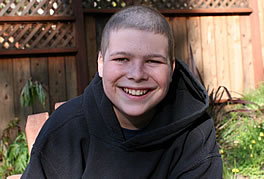|
A Note from Gary Selnow

Soon after Kate Mayer started her work with WiRED, we all learned that her 13-year-old son, Clayton, had biphenotypic leukemia, a particularly rare form of the disease. Kate shared with us the process of discovering the illness and the approach to treatment. She kept us informed about the strategies employed by the remarkable team of doctors renowned for their skills in leukemia therapies. We knew these specialists could reach out to others and they could call up thousands of databases, journal articles, monographs, and other information resources generated by a network of experts.
We were often reminded of the contrast between these doctors at the intellectual hubs of American medicine and the doctors we have been working with abroad where communications are broken, where aging journals are thumb worn from passing through too many hands for too many years.
Clayton found it incredibly unfair that others, in similar situations, might not get the kind of lifesaving information they would need to treat diseases. One day, while they were waiting for treatment Kate and Clayton discussed the introductory video for WiRED’s website. “You can use my story in the script if you want,” Clayton said. And so Clayton’s story provided the opening of the WiRED video.
Clayton is currently in remission and looking for a bone marrow donor. We’re hoping he’ll have a bone marrow transplant in the fall. But without access to the latest research on biphenotypic leukemia, we wouldn’t have even known that a bone marrow transplant is his best chance for a cure.
In response to the video, Clayton said, “If you have to go through something awful and random, it’s nice to think it might help others.”
It was Clayton’s brave decision to use his story—to help us explain the disparity between the doctors treating him and the doctors in developing countries treating a child with a similar illness. It’s Clayton’s point and it is ours, that medical knowledge is central to a doctor’s capacity to help heal a patient. Medical knowledge is the cumulative intellectual base forged by the work of thousands of physicians and researchers. The value of this knowledge may be difficult to show in a photograph, but it is made crystal clear in a story such as Clayton’s.
Clayton’s story is a poignant reminder that
Where you live should not decide if you live.
Editing by Kate Mayer and Annie Stuart, layout by Brian Colombe.
^ Back to the Top

|



